SA spinal column
5.0(1)
Card Sorting
1/59
Earn XP
Description and Tags
Study Analytics
Name | Mastery | Learn | Test | Matching | Spaced |
|---|
No study sessions yet.
60 Terms
1
New cards
how many cervical vertebraes are there
7
2
New cards
how many thoracic vertebrae are there
13
3
New cards
how many lumbar vertebrae are there
7
4
New cards
how many sacrum vertebrae are there
3
5
New cards
how many coccygeal vertebrae are there
20-23
6
New cards
what are the difference between cat and dog spinal columns in xrays
* cats have thing and long bones
* spinal column is long and rectangular
* dogs have very blocky spinal cords
* spinal column is long and rectangular
* dogs have very blocky spinal cords
7
New cards

what species is this
cat
8
New cards
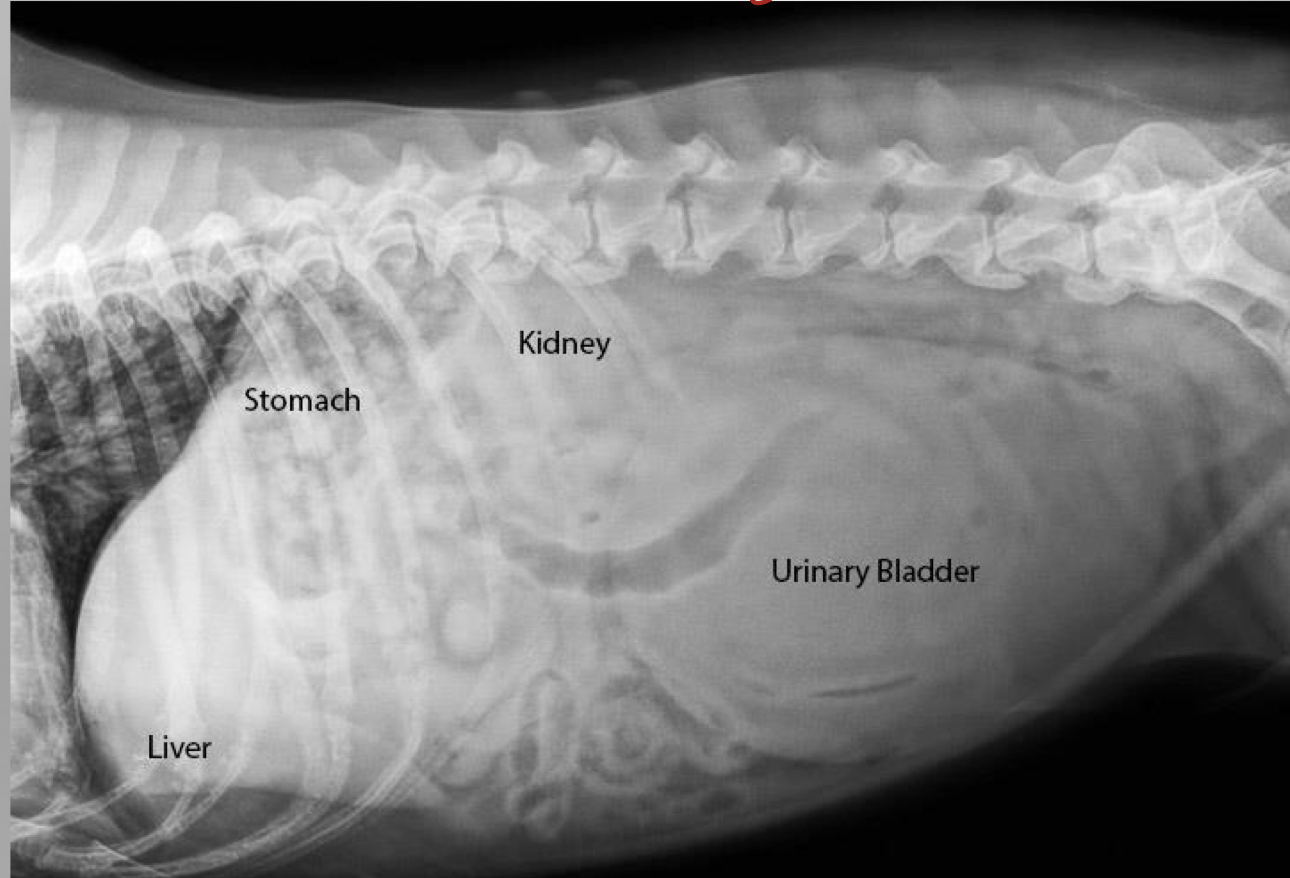
is this a cat or dog xray
dog
9
New cards
which vertebraes dont have a intervertebral disk
C1-C2
10
New cards
what does C1 do
it moves the head around
and holds the neck muscles
and holds the neck muscles
11
New cards
what is another name for C1
atlas
12
New cards

what is this?
C1 Atlas
13
New cards
another word for dens
odontoid process
14
New cards
whats significant about dens
its holds C1 and C2 together and its a very important articulation
\
\
15
New cards
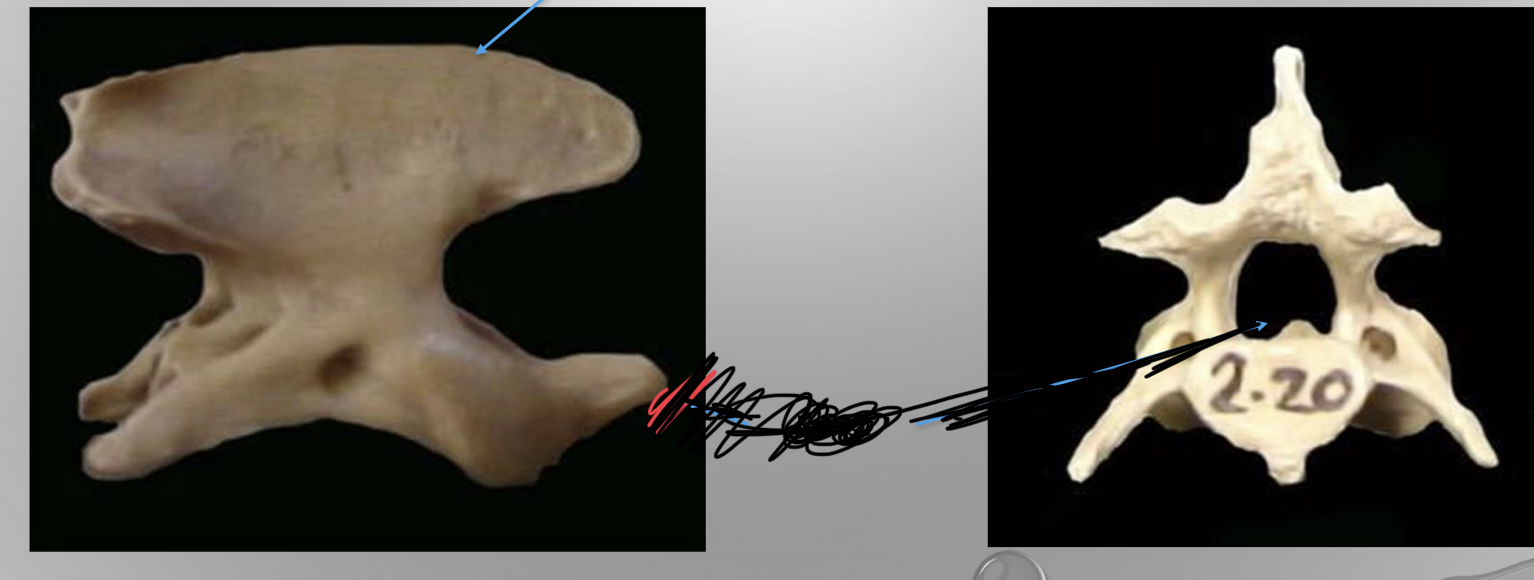
identify the vertebrae
C2 axis
16
New cards
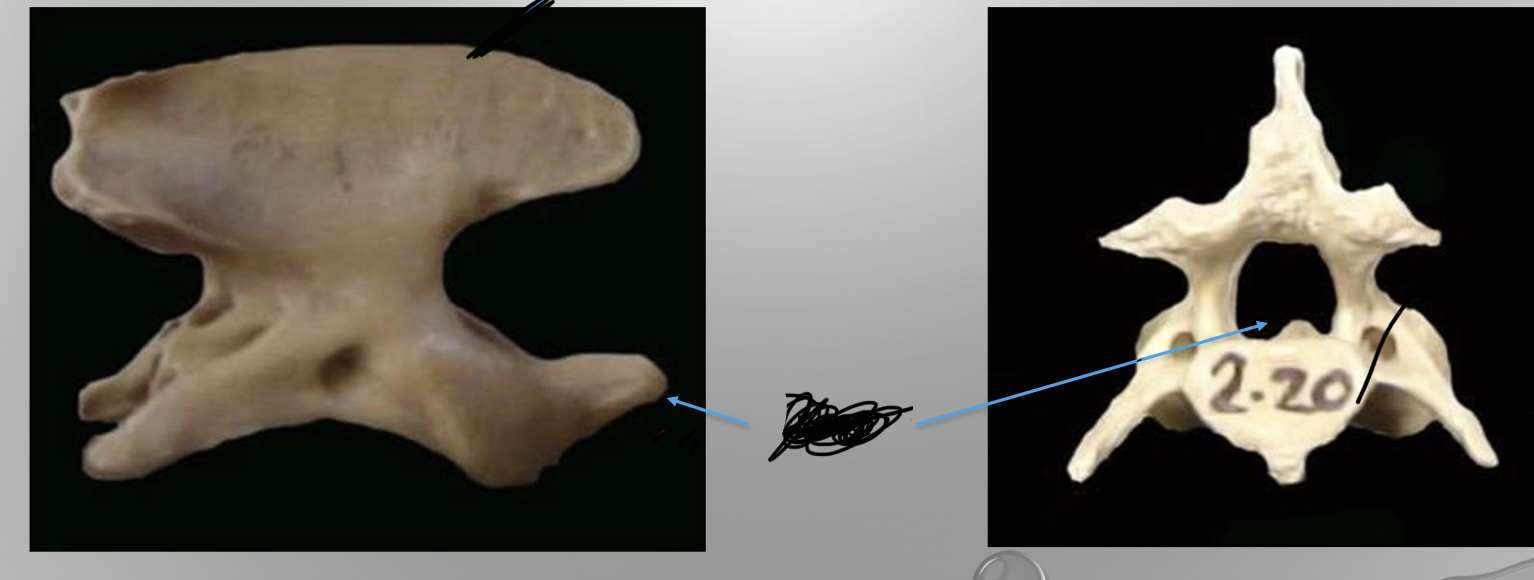
what is this part the arrow is pointing too
dens
17
New cards
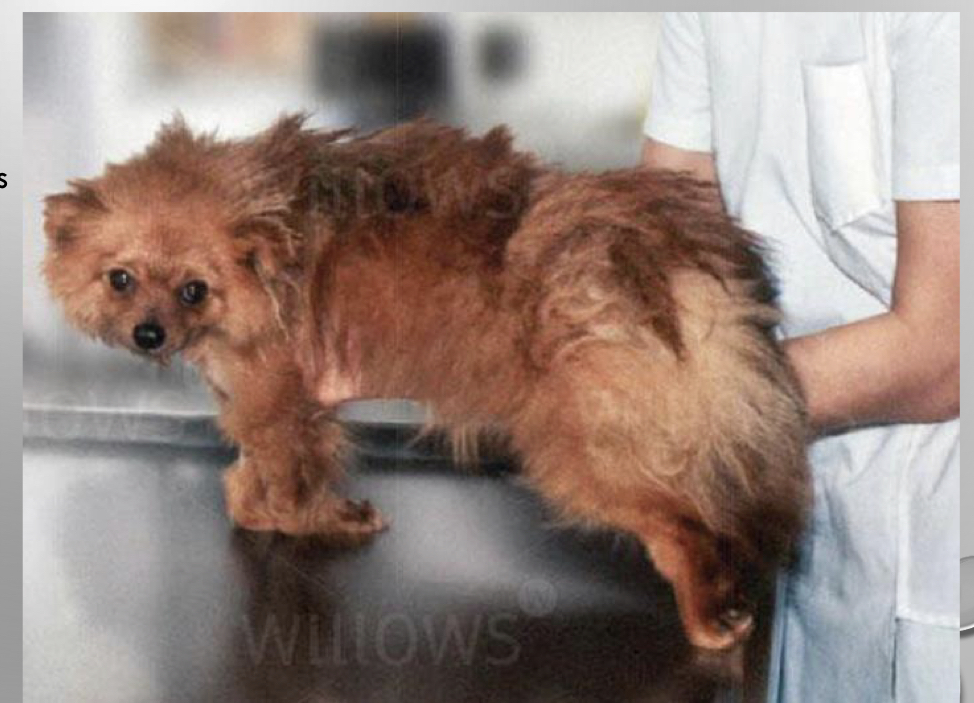
CASE
* 8 month M yorkie mix
* progessive ataxia and weakness all 4 limbs
* knucking on all 4 limbs
* holds head down most of the time
* 8 month M yorkie mix
* progessive ataxia and weakness all 4 limbs
* knucking on all 4 limbs
* holds head down most of the time
hypoplastic dens
atlanto Axial subluxation
atlanto Axial subluxation
18
New cards
what is ataxia
incoordination
dont know where the legs are
dont know where the legs are
19
New cards
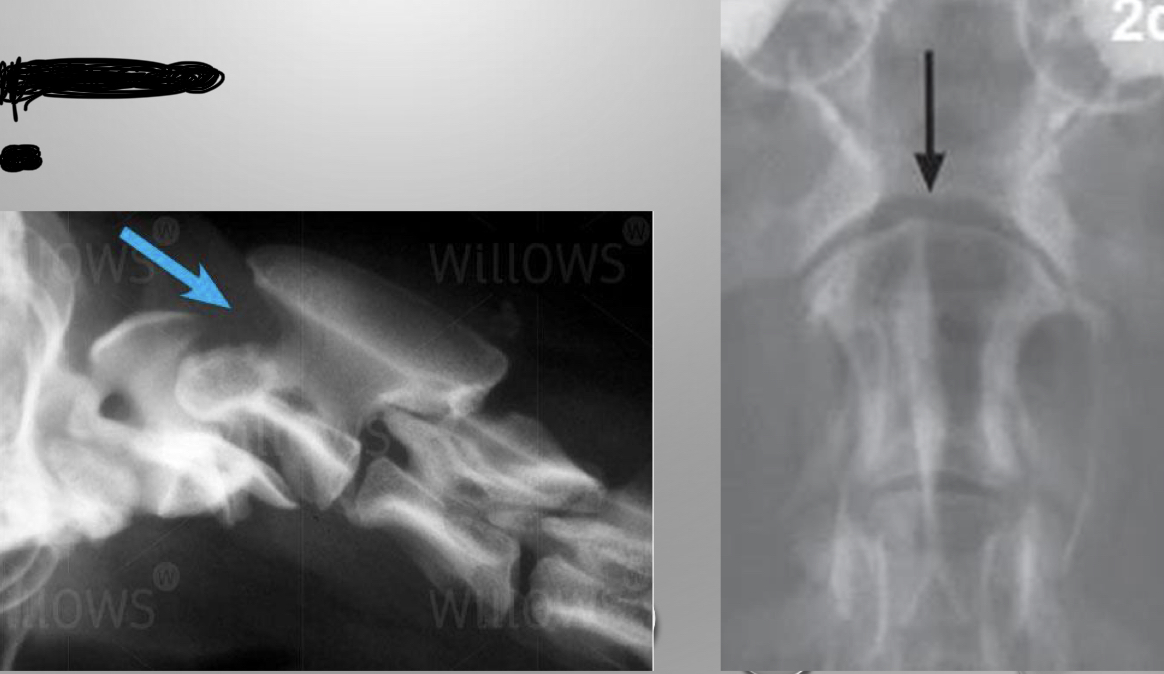
describe what is going on here
Atlanto- Azial AA subluxation
* common in miniature and toy breeds
* dens malformations along with loss/weaking of ligamentous structures
* cervical pain and neurologic deficits
* common in miniature and toy breeds
* dens malformations along with loss/weaking of ligamentous structures
* cervical pain and neurologic deficits
20
New cards
what does a normal xray of C1 and C2 look like
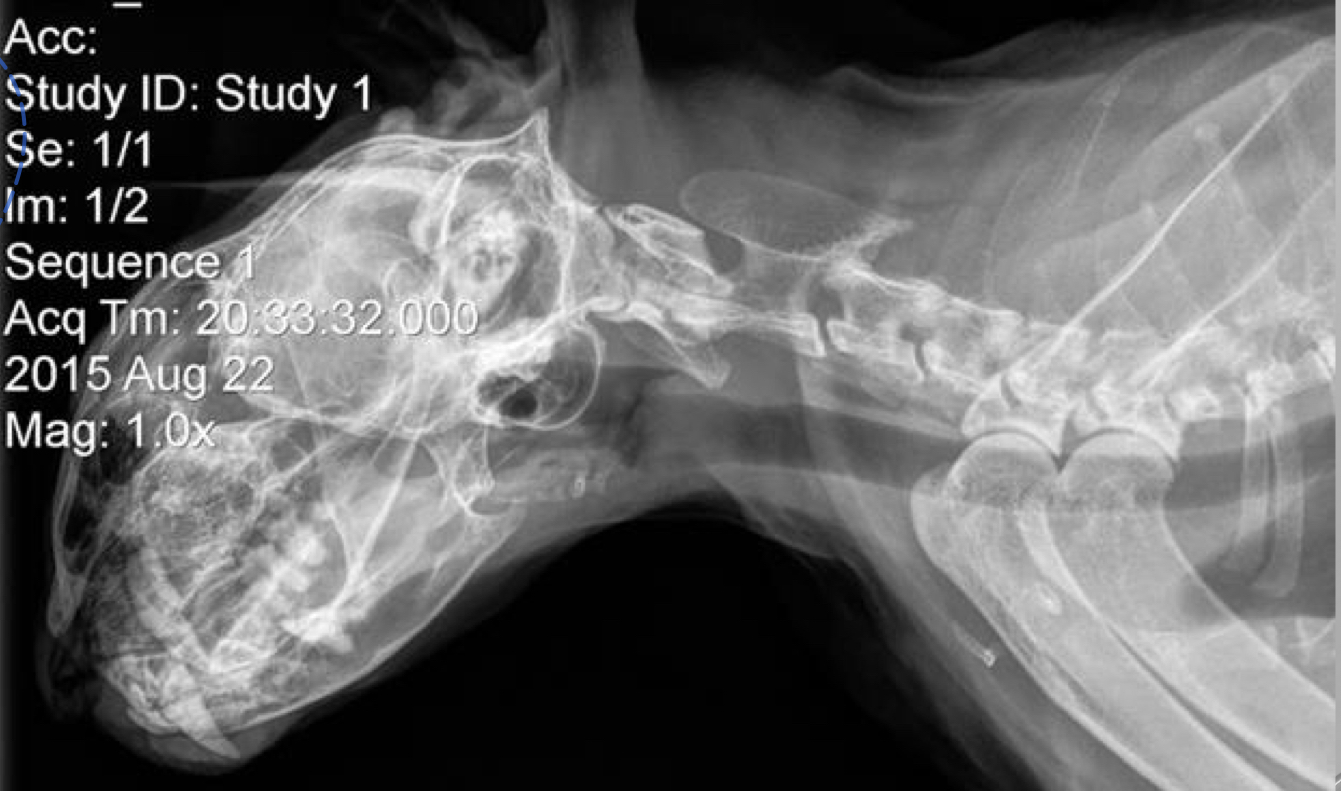
21
New cards
what are the ligaments of C2
* transverse ligament of atlas
* alar ligament
* apical ligament of dens
* nuchal ligament
* dorsal atlantoaxial ligament
* alar ligament
* apical ligament of dens
* nuchal ligament
* dorsal atlantoaxial ligament
22
New cards
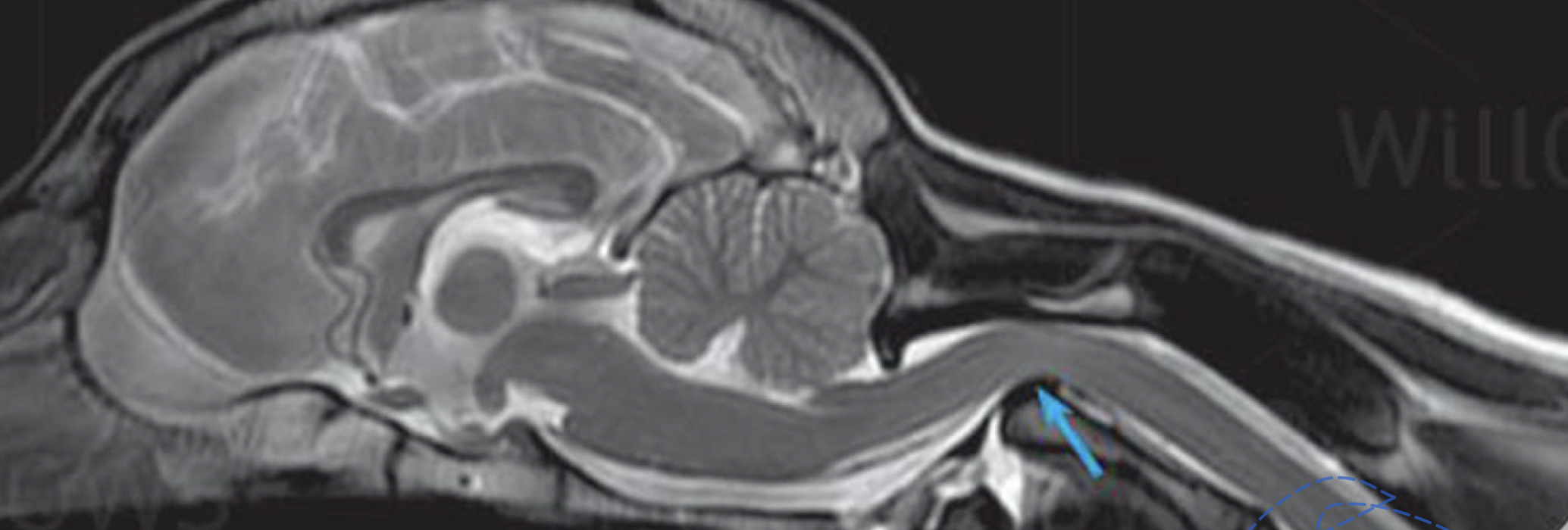
what kind of picture is this and what is going on
MRI of AA subluxation
23
New cards
how to fix a AA subluxation
* surgery
* fuse c1 and c2
* recover full sensation
* cement it back in place
* fuse c1 and c2
* recover full sensation
* cement it back in place
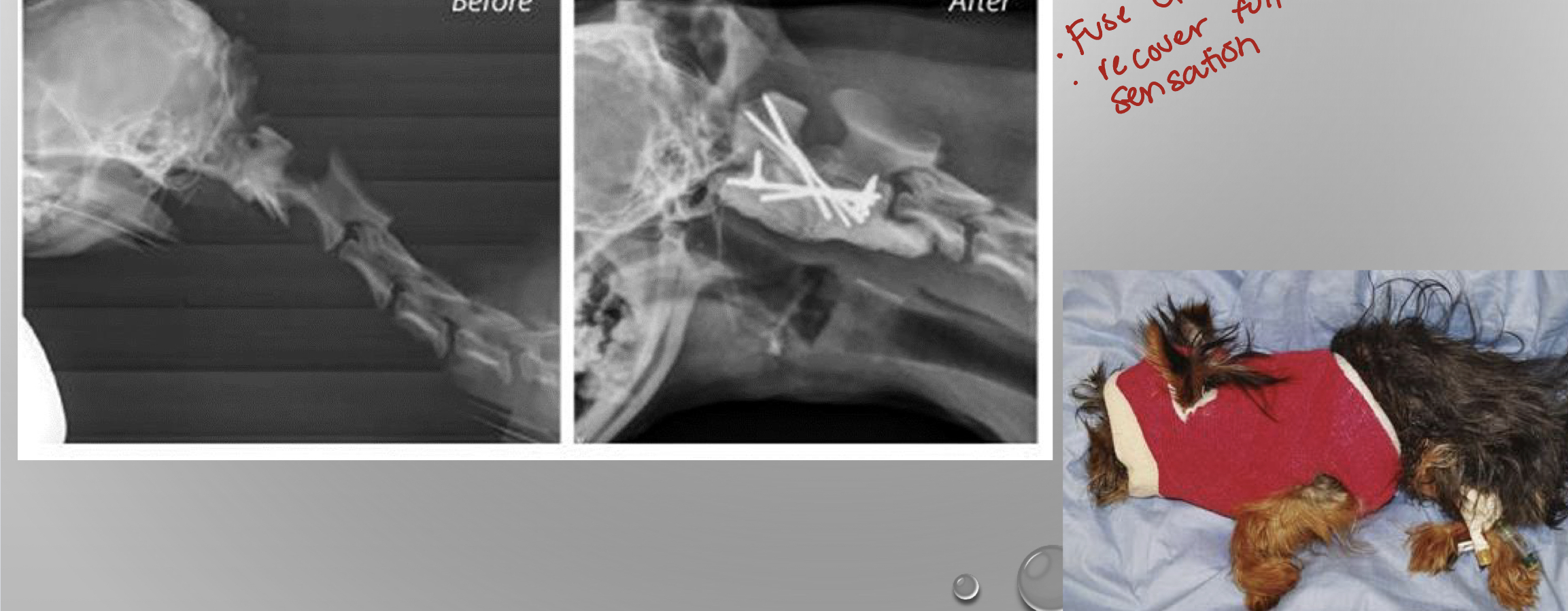
24
New cards
which cervical vertabrae is important for xray landmarks
C6
it has a large transverse process
it has a large transverse process
25
New cards
how many cervical nerves are there
8
26
New cards
what is important about C6-T2
concentration of lower motor neurons=nerves of the brachial plexus
27
New cards
what are the main nerves of the brachial plexus
* suprascapular
* musculocutaneous
* axillary
* radial
* thoracodorsal
* median
* ulnar
* lateral thoracic
* musculocutaneous
* axillary
* radial
* thoracodorsal
* median
* ulnar
* lateral thoracic
28
New cards
whats the main nerve that comes off L4-S1
femoral nerve
29
New cards
whats the main nerve that comes off S1-S3
sciatic
30
New cards
where would you collect cerebrospinal fluid
* cerebellomedullary cistern
* in between the occipital protuberance and wing of atlas
\
* in between the occipital protuberance and wing of atlas
\
31
New cards
describe thoracic vertebra
they have long spinal processes
32
New cards
t11 important why
also called anticlinical
its a landmark that tells u exactly where t11 is because the spinal process switches directions
its a landmark that tells u exactly where t11 is because the spinal process switches directions
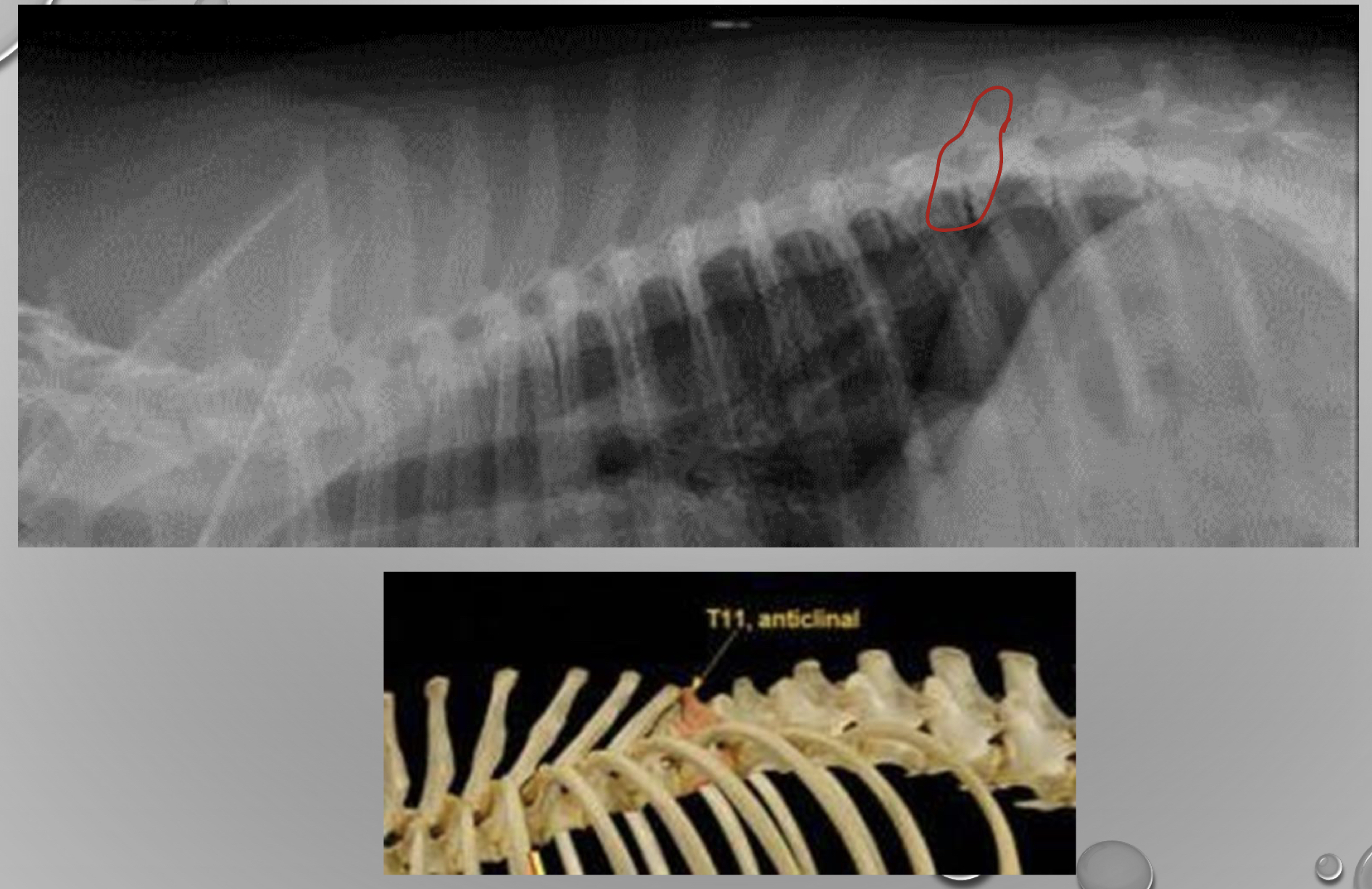
33
New cards
what keeps t2 and t11 from getting disc disease
intercapital ligament
34
New cards
where is the dorsal longitudinal ligament
lies on the floor of the vertebral canal and runs from the dens to the sacrum
35
New cards
what vertebrae is the most common for disc disease
lumbar vertebrae
there is a lot of movement
there is a lot of movement
36
New cards
What cant you see in a normal lumbar verterbrae xray
you cant see the spinal cord
37
New cards
where can you tap for cerebrospinal fluid in the lumbar region
in between L5 and L6
in the subarachnoid space
in the subarachnoid space
38
New cards
what is myelogram
where you stick contrast material to see the spinal cord

39
New cards
what are the differences between cervical and lumbar spinal canals
cervical spinal canal is much wider than the lumbar
40
New cards
where is the epidural space
L7 and S1
lumbosacral epidural
lumbosacral epidural
41
New cards
what are the four landmarks for an epidural
* ilial wings
* dorsal spinous process of L7
* sacral vertebrae
\
* dorsal spinous process of L7
* sacral vertebrae
\
42
New cards
where does the spinal cord end
L6-L7
43
New cards
what is cauda equina
caudally streaming spinal roots innervating pelvic viscera and tail
44
New cards
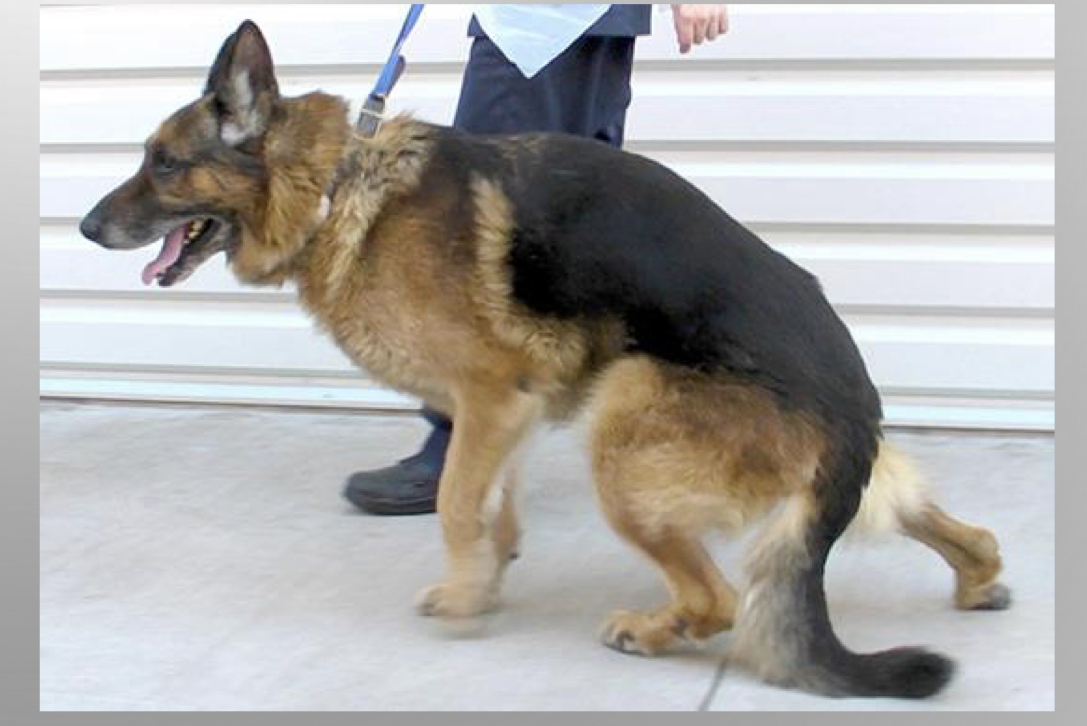
CASE
* 7yr Male Intact germnan shepherd- working dog
* decreased willingness to jump into truck
* low tail carriage
* difficulty posturing to defecate
* pain on palpation of the lower back and on tail lift
* 7yr Male Intact germnan shepherd- working dog
* decreased willingness to jump into truck
* low tail carriage
* difficulty posturing to defecate
* pain on palpation of the lower back and on tail lift
lumbosacral stenosis
cauda equina syndrome
* painful lower back/ tail
* L7-S1 damaged
* not the spinal cord its the spinal roots
* femoral nerve
* sciatic
* pudendal
* pelvic
* coccygeal
cauda equina syndrome
* painful lower back/ tail
* L7-S1 damaged
* not the spinal cord its the spinal roots
* femoral nerve
* sciatic
* pudendal
* pelvic
* coccygeal
45
New cards
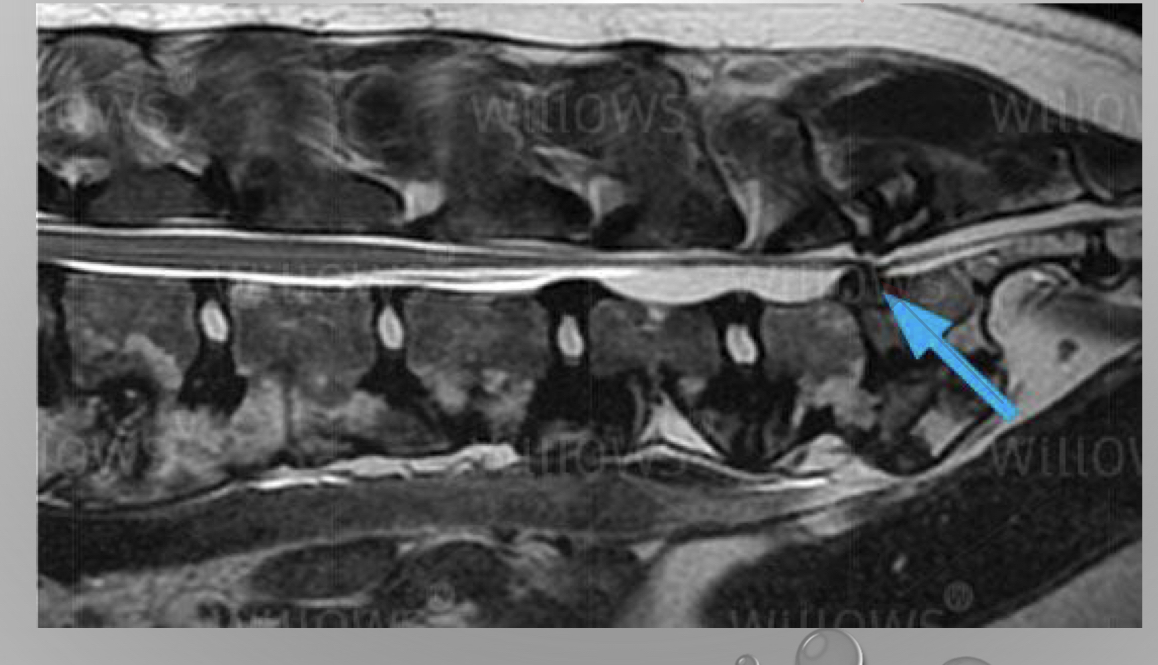
what is going on and what type of image is this
lumbosacral stenosis
cauda equina syndrome
mri bone=dark
fluid=light
cauda equina syndrome
mri bone=dark
fluid=light
46
New cards
what is the sacroiliac joint
bodies of the 3 sacral vertebrae fuse to form the sacrum
47
New cards
what are the sacral ligaments
1. dorsal sacroiliac ligament (also a ventral)
2. sacrotuberous ligament
48
New cards
what ligaments do cats not have
sacrotuberous ligament
49
New cards
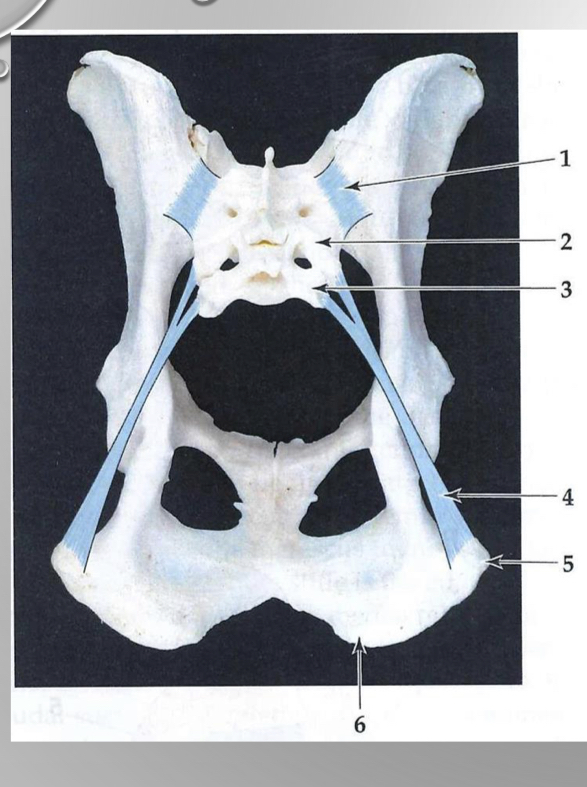
label 1-4
1. dorsal sacroiliac ligament
2. sacrum
3. 1st coccygeal vertebrae
4. sacrotuberous ligament
50
New cards
what holds the ilium to the sacrum
sacroiliac ligament
51
New cards
CASE
* 4 yr Male intact chihuahua
* hit by car
* multiple laceration and unable to stand on his back legs
* 4 yr Male intact chihuahua
* hit by car
* multiple laceration and unable to stand on his back legs
fractures on the weight bearing axis
* fractured pubis -preventing from walking
* fractured iscchium
* sacroiliac luxation -preventing from walking
put pins on the sacroiliac luxation and everything is shifted back
* fractured pubis -preventing from walking
* fractured iscchium
* sacroiliac luxation -preventing from walking
put pins on the sacroiliac luxation and everything is shifted back
52
New cards
where is it common for vertebraes to fuse
common in the cervical region
increases the risk of intervertebral disk disease
bulldogs, frenchies are at greater risk for this
increases the risk of intervertebral disk disease
bulldogs, frenchies are at greater risk for this
53
New cards
what are hemivertebrae
* failure of the development and ossification of part of a vertebrae
* usually a vertebral body
* can lead to compression of the spinal cord
* french bulldogs, pugs, bulldogs
* not a fuse
* usually a vertebral body
* can lead to compression of the spinal cord
* french bulldogs, pugs, bulldogs
* not a fuse
54
New cards
what is a transitional vertebrae
when something is not supposed to be there
but its not a bad thing
but its not a bad thing
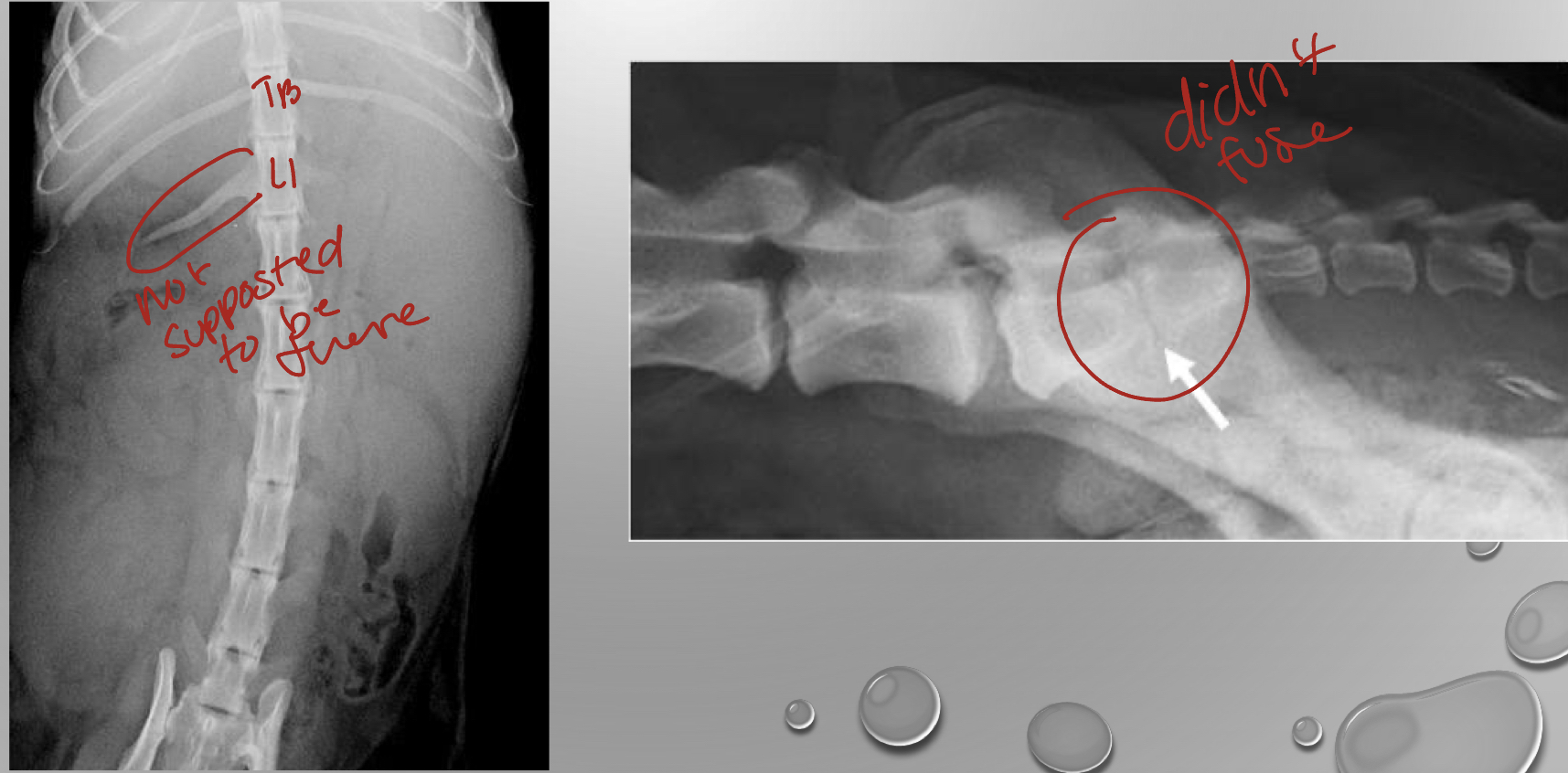
55
New cards
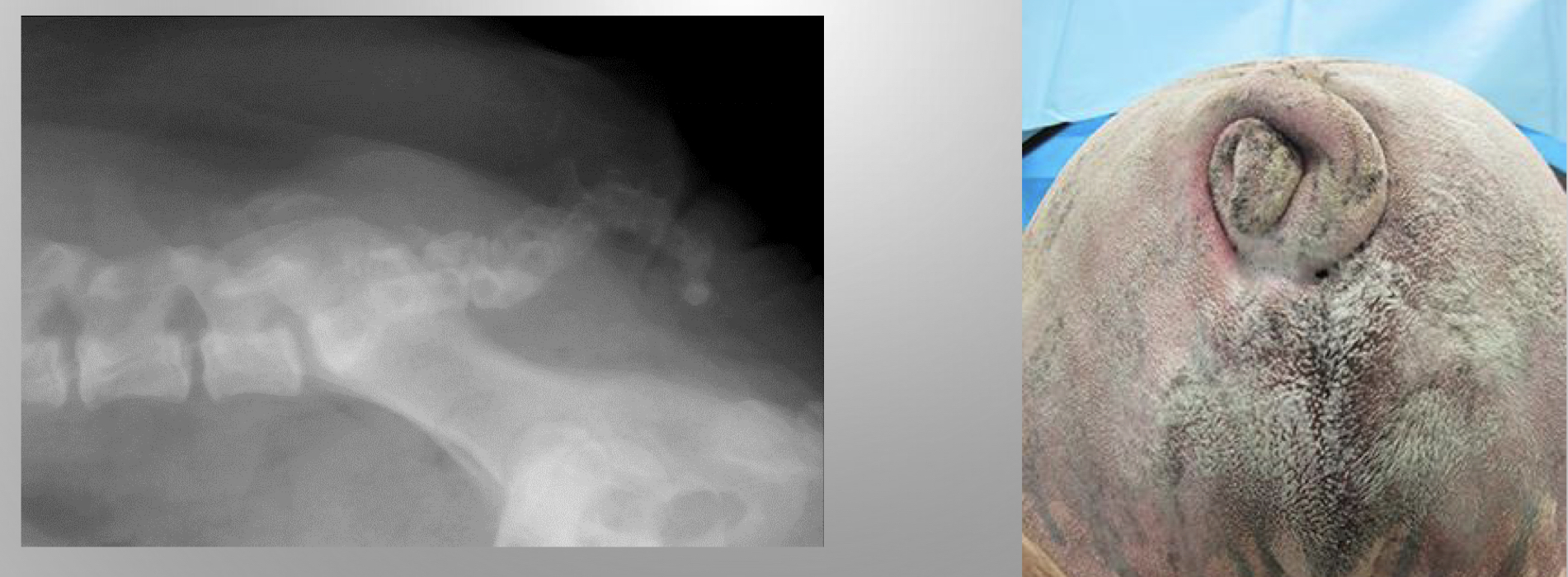
CASE
* 2yr male english bulldog
* chronic skin irritation around his tail
* moist dermatitis
* painful to tock and clean
* 2yr male english bulldog
* chronic skin irritation around his tail
* moist dermatitis
* painful to tock and clean
* screw tail
* malformation of one to several vertebrae in the tail
* most common in bulldogs
* you amputate tail
* malformation of one to several vertebrae in the tail
* most common in bulldogs
* you amputate tail
56
New cards
what is significant about manx cats
* dominant mode of inheritance- homozygous is lethal
* abnormal development of the sacral and coccygeal vertebrae
* “manx syndrome” some cats have no problems vs severe neurologic conditions
* abnormal development of the sacral and coccygeal vertebrae
* “manx syndrome” some cats have no problems vs severe neurologic conditions
57
New cards
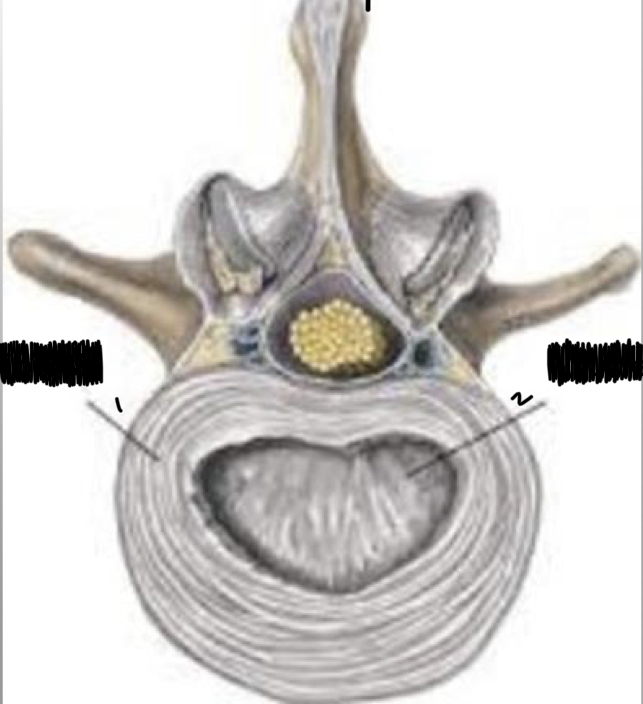
identify
nucleaus pulposus
annulus fibrosis
nucleaus pulposus
annulus fibrosis
1. annulus fibrosis
2. nucleus pulposus
58
New cards
CASE
* 4 yr MN dachshund
* jumped off the couch and screamed in pain
* lost motor function in both hind legs
* can feel but not move
* 4 yr MN dachshund
* jumped off the couch and screamed in pain
* lost motor function in both hind legs
* can feel but not move
intervertebral disc disease
59
New cards
describe intervertebral disc disease
* dachshunds and other “chondrodystophic” breeds predisposed
* nucleus pulposus dehydrates and becomes dry and brittle
* risk of traumatic extrusion into the spinal cord
* nucleus pulposus dehydrates and becomes dry and brittle
* risk of traumatic extrusion into the spinal cord
60
New cards
what is a hemilaminectomy
spine surgery that involves removing parts of one of the two laiminae on a vertebra to relieve excess pressure on the spinal nerves in the lumbar spine